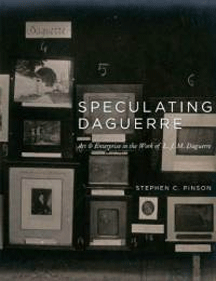By Svetlana Alpers
The name Daguerre brings two things to mind. First, the heated debate about who, c. 1839, invented photography: Was it Louis Daguerre and Nicéphore Niépce in France or Henry Fox Talbot in England? And second, those furtive images glimpsed on pieces of copper known, after him, as daguerreotypes. Pinson’s book, concluding with a catalogue of the works on paper, paintings as well as photographs attributed to Daguerre, wants us to view him, and so also the beginning or is it emergence of photography, differently.
The book offers an account of the social, political, and artistic history of what is described as a speculative culture. The meanings attached at the time to the French word spéculation are applied by extension to a culture which combined natural observation, artistic creation, and commercial enterprise. That culture is exemplified by Daguerre (1787-1851).
The man remembered best as the inventor of a type of photography had a life-long career as a painter. Arriving in Paris before he was twenty, he submitted a painting to the Salon which was bought by the Louis XVIII. He had steady employment, making large scenic works for the Paris Opera. He moved on from there to paint panoramic views for a Diorama which was financed and built by a company he organized backed by shareholders. The scenic display made captivating by changing colors and changing lighting drew paying crowds beginning in the 1820s. In 1824 he was awarded the Legion of Honor for it. Daguerre was an artist engaged with optical naturalism and he was also an entrepreneur. So, he was engaged with the three senses of speculation—seeing, making, and commerce. In the end, one artistic enterprise dealing with vision was literally built on another. In 1839, the two daguerrotypes of the Boulevard du Temple for which Daguerre the photographer is known, were made from the roof of his Diorama just before it burned to the ground.
Pinson has included a huge amount of material in this book. The restlessness of his text is suited perhaps to the subject—the life, practice and makings of an ambitious man in the midst of multiple projects in changing times. A virtue is that it insists on the cultural imbeddedness of Daguerre’s various practices and the works he made. The argument is that photography is part of this mix.
It is said these days that the digital revolution marks the end of photography as we have known it. But what does that mean? This book shows that photography was impure—in other words not a single essential thing springing from a single root—from the beginning. Less convincing is Pinson’s assumption that Daguerre’s ambition and the recognition he received trump the question of artistic achievement. It matters that the works illustrated here show that he was not a very good painter. Surely, it is the daguerrotypes, his still views of Paris and of statuary, that is the art to remember him for ( or do they only seem magical because they were so new and there is little to compare them to?)
Svetlana Alpers, an artist, critic and renowned art historian, is professor emerita of the history of art at the University of California, Berkeley and a visiting scholar in the Department of Fine Arts at New York University.




